Posts Tagged labor relations
 FMC Cascade Tomato Harvester in Use, circa 1985 / THF146505
FMC Cascade Tomato Harvester in Use, circa 1985 / THF146505
The adoption of mechanical tomato harvesters in the 1960s both industrialized tomato production and ushered in a countermovement of small growers and local food advocates. How could one machine prompt such contradictory but real changes in agriculture? The full story spans decades and reveals complex relationships of supply and demand—for both agricultural products and the people who grow and harvest them.
Shortage and Struggle

California’s labor shortage threatened the supply of processing tomatoes for ketchup, sauces, tomato juice, canned tomatoes, and other products. Can label, "Del Monte Brand Spanish Style Tomato Sauce," circa 1930. / THF294183, detail
To meet rising demand for processing tomatoes (to be made into ketchups, sauces, tomato juice, canned tomatoes, and other products) in the early 20th century, growers needed laborers to pick them. Those laborers, in turn, needed living wages. Tensions between growers and laborers came to a head during the New Deal era of the 1930s, when government policies promised minimum wages, maximum hours, and workers’ compensation. Yet, lobbyists working for growers and agricultural processers convinced policy makers to exempt agricultural workers from these protections.
Laborers voted with their feet, seeking employment beyond farm fields. This caused a critical labor shortage that became even more acute during World War II for growers raising tomatoes and other crops in California and beyond. To meet demand, the United States and Mexican governments negotiated the Mexican Farm Labor Agreement. This guest labor program brought millions of farmworkers, known as braceros, from Mexico to work in the United States for short periods of time between 1942 and 1964.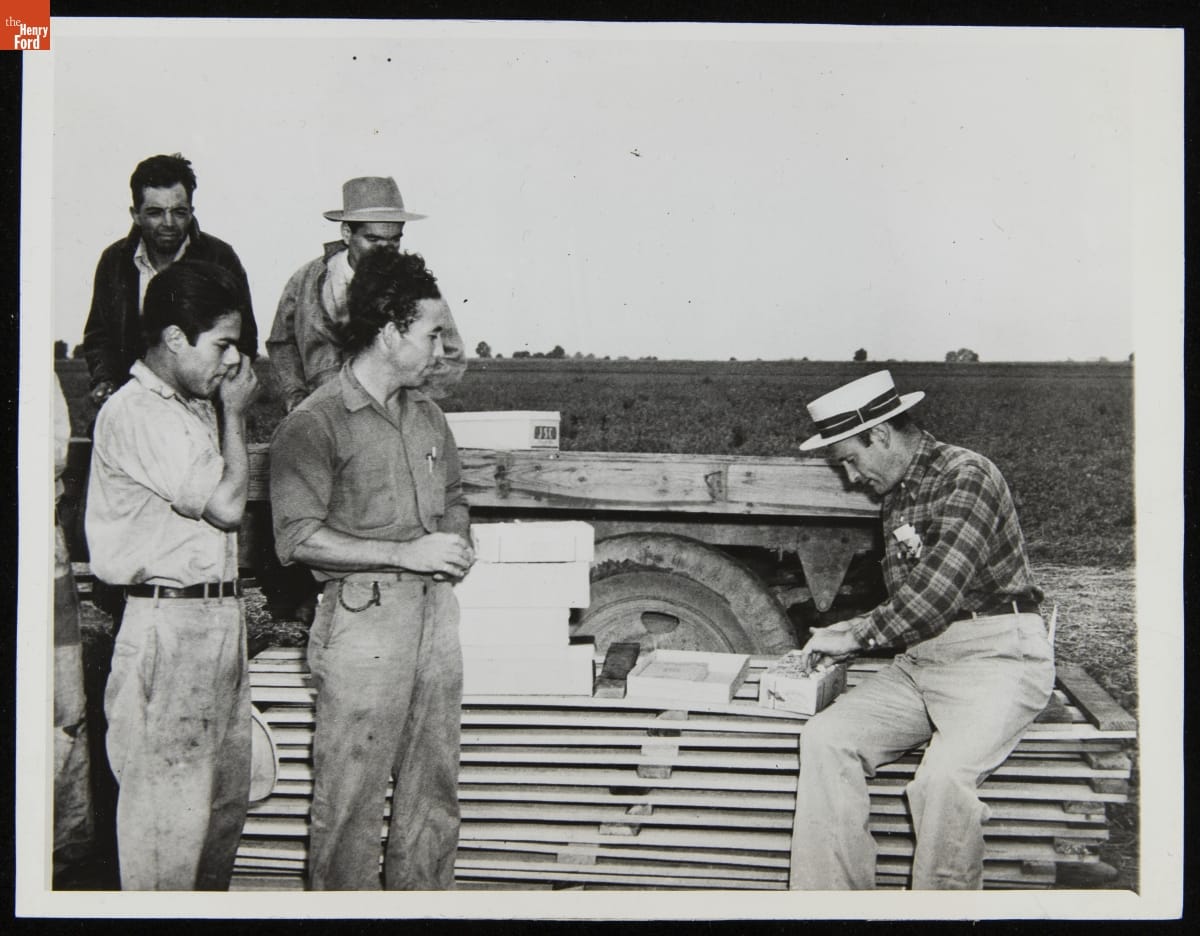
This photograph illustrated a news report on braceros resuming the tomato harvest near Danville, Illinois, in August 1945. / THF147934
A chain of events during the 1960s called attention to the plight of agricultural laborers. Edward R. Murrow’s television documentary Harvest of Shame (1960) highlighted the precarious existence of migrant laborers who worked picking perishable fruits and vegetables in the Midwest and along the East Coast. The Bracero Program expired in 1964, reducing the number of available laborers and increasing growers’ dependence on the existing labor pool. Congress passed the Civil Rights Act of 1964, which, along with other anti-poverty and housing legislation, made it clear that migratory and seasonal laborers had the right to humane treatment.
On the West Coast, Filipino laborers organized as part of the Agricultural Workers Organizing Committee. Seeking better wages and a more favorable rate of payment, they launched a grape strike that expanded into Delano, California, in 1965. The National Farm Workers Association, consisting mostly of Mexican migratory workers, joined the cause. This coordinated effort resulted in a new organization, the United Farm Workers (UFW), with Cesar Chavez as president.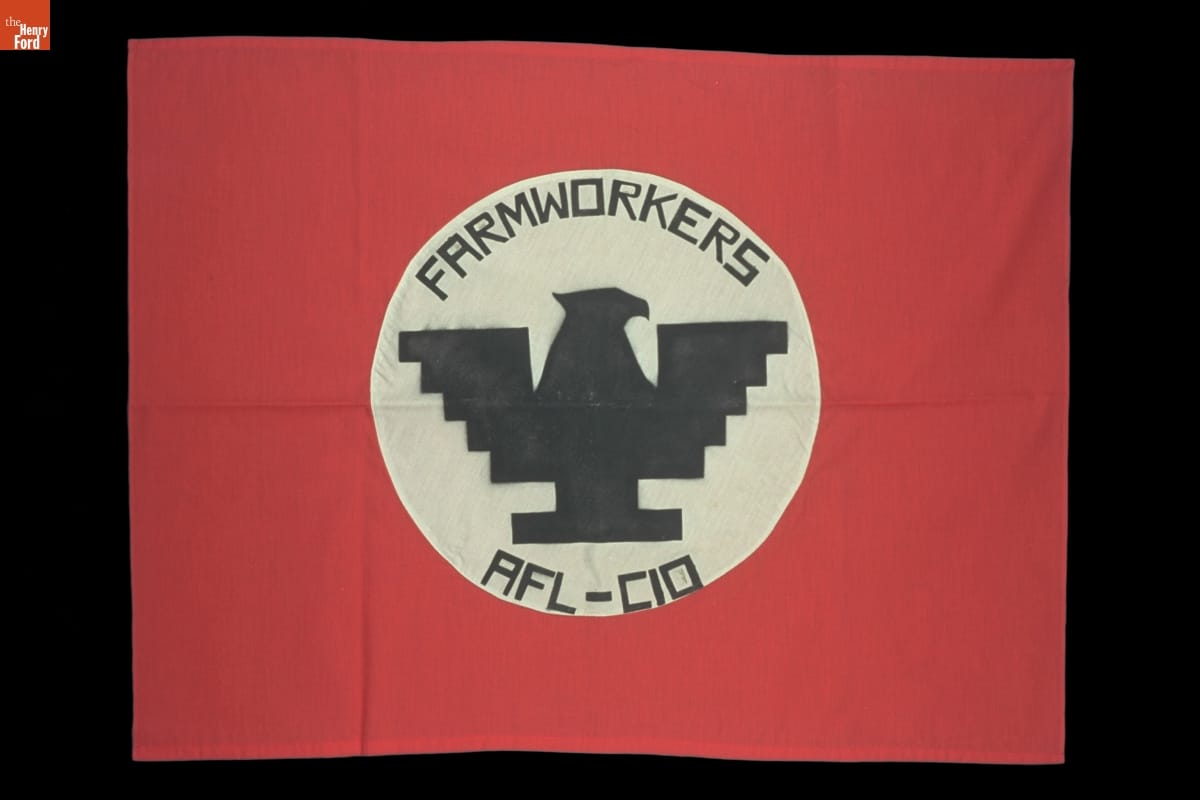
The organizing efforts of groups like the United Farm Workers to secure better wages and living conditions for agricultural laborers in California gained national attention in the 1960s. United Farm Workers flag, circa 1970. / THF94392
The UFW devised innovative solutions to increase pressure on growers, and—especially due to the efforts of co-founder Dolores Huerta—built the Delano grape strike into a national boycott. This focused attention on basic needs for migratory and seasonal laborers. In addition to ensuring some protections for individuals, the coordinated effort secured the right for migratory and seasonal laborers as a class to collectively bargain.
Engineering a Solution to Labor Shortages
Tomato growers, keen on getting their crop planted, cultivated, and harvested at the optimum times, were interested in mechanical solutions that could address labor shortages. Mechanizing the harvest of this perishable commodity, however, proved to be a time-consuming challenge.
Scientists at the University of California, Davis (UC Davis), sought a labor shortage solution through mechanical and biological engineering. Research and development begun in the 1940s finally resulted in the successful design of both a mechanical tomato harvester (created in partnership with Blackwelder Manufacturing Company) and a tomato that could withstand mechanical harvesting (the VF145).

Top: UC Davis vegetable crops researcher Gordie “Jack” Hanna developed the machine-harvestable VF145 tomato. Bottom: An early mechanical tomato harvester underway. Images from the 1968 USDA Yearbook, Science for Better Living. / THF621133 and THF621134
By 1961, Blackwelder had released a commercial harvester and recommended the VF145 tomato for optimum mechanical harvesting. FMC Corporation released a competing harvester by 1966. Manufacturers touted the labor-saving value of mechanical harvesters at a time when the supply of laborers was too small to meet demand, and the adoption of this new technology was swift. In 1961, 25 mechanical harvesters picked about one-half of one percent of California’s tomato crop. Between 1965 and 1966, the number of harvesters doubled from 250 to 512 and the percentage of mechanically harvested tomatoes in California rocketed from 20 percent to 70 percent. By 1970, the transition was complete, with 99.9 percent of California’s tomato crop harvested mechanically. (For more, see Mark Kramer’s essay, "The Ruination of the Tomato," in the January 1980 issue of The Atlantic.)
Contradictory Impact
Some might claim mechanical harvesters helped save California’s processed tomato industry—by 1980, California growers produced 85 percent of that crop. But a closer look reveals a more complicated cause-and-effect. While growers could theoretically save their crop by replacing some labor with machines, many small-scale growers could not save their businesses from large-scale competition. By 1971, the number of tomato farmers had dropped by 82 percent. (This consolidation was mirrored elsewhere in the industry, as just four companies—Del Monte, Heinz, Campbell, and Libby’s—processed 72 percent of tomatoes by 1980.)
Tomato harvester advertisements promised farmers could save their businesses by replacing scarce laborers with machines, but many small-scale growers could not save themselves from large-scale competitors. Advertisement for FMC Corporation Tomato Harvester, circa 1966. / THF610767
A group of growers sued UC Davis, challenging the school for investing so much to develop the tomato harvester without spending comparable resources to address the needs of small farmers. In response, UC Davis opened its Small Farm Center, an advocacy center for alternative farmers, in 1979. These events coincided with wider efforts to hold the United States Department of Agriculture accountable for unequal distribution of support, resulting in increased attention at the national level to economically disadvantaged and ethnically diverse farmers. Around this same time, food activist Alice Waters raised awareness through her advocacy of locally sourced foods. Her restaurant, Chez Panisse, founded in Berkeley, California, in 1971, became an anchor for the burgeoning Slow Food movement.
So, while mechanical tomato harvesters—like the one on exhibit in Henry Ford Museum of American Innovation—represent large-scale scientific and industrial advances, they also offer insight into this country’s complex labor history and help tell stories about small-scale farmers and their connections to communities, customers, and all of us who eat.
Debra A. Reid is Curator of Agriculture & the Environment at The Henry Ford. Adapted by Saige Jedele, Associate Curator, Digital Content, at The Henry Ford.
Additional Readings:
- Agriculture and the Environment
- Bringing in the Beans: Harvesting a New Commodity
- Women in Agricultural Work and Research
- As Ye Sow So Shall Ye Reap: The Bickford & Huffman Grain Drill
farming equipment, research, labor relations, Hispanic and Latino history, food, farms and farming, by Saige Jedele, by Debra A. Reid, agriculture
Kalamazoo, Michigan, is known for its industry. For a relatively small midwestern city, it became a leader in the production of an impressive number of products, some more readily remembered today than others—including celery, paper, stoves, taxicabs, guitars, craft beer, and pharmaceuticals. At the turn of the 20th century, the Kalamazoo Corset Company gave the city more reasons to be noticed—for its high output of corsets, the advertising used to sell them, and for an historic labor strike, led primarily by women.
The Kalamazoo Corset Company began as the Featherbone Corset Company. The company’s name changed in 1894, a few years after the company was relocated 70+ miles from Three Oaks, Michigan, to the city of Kalamazoo. As the original name suggests, the company prided itself on its innovative use of turkey wing feathers—“featherbone”—which replaced the occasionally malodorous whalebone corsets (while these corsets were referred to as containing “whalebone,” it was actually whale baleen that was used, which is not bone).
While the company featured numerous lines of corsets, by 1908, they were focusing on advertising for their “American Beauty” line. These corsets were named to reflect a version of an idealized American woman—an “American Beauty.” Charles Dana Gibson had created his version of the feminine ideal of physical attractiveness, the “Gibson Girl,” during the 1890s—this “American Beauty” followed in her footsteps. The company’s use of “American Beauty” also likely referenced a deep crimson hybrid rose bred in Europe in 1875, which by the turn of the 20th century was popularized in America as the rather expensive American Beauty Rose. By associating their corset line with both the concept of the quintessential American girl and the coveted American Beauty Rose, they were sending a message to the consumer—"buy our corset and you too will take on these qualities!”
Kalamazoo Corset Company "American Beauty Style 626" Corsets, 1891-1922 / THF185765
Promotional songs that advertised a product were becoming increasingly popular at the time. Since the end of the Civil War, Americans had been purchasing parlor pianos for their homes in great numbers—as many as 25,000 per year. The parlor piano became the center of most Americans’ musical experience. Music publishers, like those in the famous Tin Pan Alley of New York City, took note and sold sheet music aimed at these amateur musicians. The rise of music publishing led to a new mode of advertising for retailers and manufacturers. How better to promote your product than by creating a tune that consumers could play in their homes? It seems the Kalamazoo Corset Company agreed, hiring Harry H. Zickel and the Zickel Bros. to write three such songs to advertise the “American Beauty” line: the “American Beauty March and Two-Step” (1908), “My American Beauty Rose: Ballad” (1910), and “My American Beauty Girl” (1912).
My American Beauty Rose: Ballad, 1910 / THF621565
Around the time these songs were being written, issues at the company began to come to light. The company was a major employer in the area, employing 1026 people, 835 of whom were women, in 1911. This made the company the largest employer of women in Kalamazoo. First in 1911, and then again in 1912, around 800 mostly female workers went on strike. They formed the Kalamazoo Corset Workers’ Union, Local 82 of the International Ladies Garment Workers Union (ILGWU), and protested unequal wages, unsanitary working conditions, and sexual harassment.
The strike gained national attention and the ILGWU headquarters in New York City sent well-known women’s rights advocates Josephine Casey and Pauline Newman to Kalamazoo to assist in the negotiations. The strike looked to New York as an example—the infamous Triangle Shirtwaist Factory fire and subsequent “Uprising of the 20,000” strike of 1909–1910 had sparked more uprisings, some far from New York City, as in Kalamazoo’s example.
The Story of the I.L.G.W.U., 1935 / THF121022
The protesters received support from local unions, but the owner of the company, James Hatfield, was a prominent Kalamazoo businessman and was well-liked among his upper-class peers. Local women’s organizations did not come to the aid of the protestors. Even the local group of suffragettes did not openly support the strike, possibly due to class issues (the suffragettes were upper class, while the women protesting were working class) or because their focus was on getting a women’s suffrage amendment to the state’s constitution passed. The women of the Kalamazoo Corset Company faced an uphill battle to obtain even a semblance of equality in the workplace.
The strike ended on June 15, 1912, ultimately unsuccessful. While an agreement was reached which addressed many of Local 82’s demands, no measures were put in place to ensure adherence, and the company quickly lapsed in its promises. Within just a few years, James Hatfield left the company to begin another, and the company was renamed Grace Corset Company. Between the financial woes wrought by the strike and changing fashions, difficult days for the company were ahead.
The Kalamazoo Corset Company’s business was women—manufacturing garments for women, shaping idealized notions of women—but it was still unable to adequately value the many women it employed by creating an equitable and safe workplace. In the end, the inability of the company to recognize the value of the gender by which they made their business helped to ensure its downfall.
Katherine White is Associate Curator, Digital Content, at The Henry Ford.
20th century, 19th century, women's history, music, Michigan, manufacturing, labor relations, fashion, by Katherine White
The Search for Home
Detroit Reacts to the Great Migration: Before the first World War, a majority of Detroit's African American population lived on the East Side and shared the area, known as Black Bottom, with white immigrant populations. At this time, relatively few African Americans, just 1.2% of the total population, called Detroit home. By 1930, the city’s African American population had grown by over 1,991%. The white immigrant population began to vacate the Black Bottom area and were quickly replaced with the growing population of African Americans attracted to the north by the promise of employment in Detroit’s booming auto industry and an escape from the rampant oppression of the south. As the African American population in Detroit increased, racial residential boundaries began to form, due in part to the stress on housing stock, as well as to outright discrimination in institutions such as employment and real estate.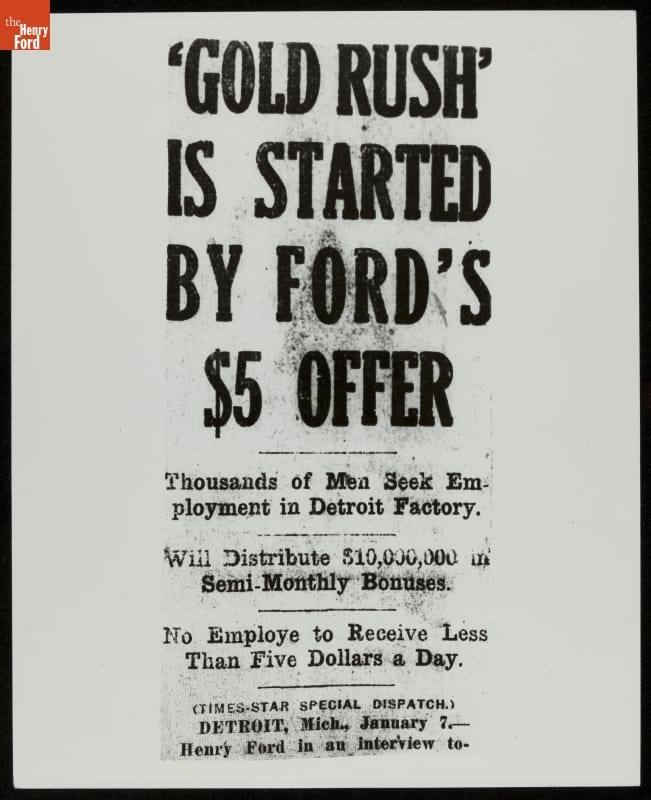
Photographic print - "Newspaper Article, "Gold Rush is Started by Ford's $5 Offer," January 7, 1914" - Ford Motor Company
The automobile industry and Henry Ford’s highly-publicized $5-a-day helped to draw people in great numbers to the Detroit area. However, for African American workers, reality often differed from their hopes and expectations in the north. While many of the automotive manufacturers did hire African Americans, it was almost always for the lowest paying jobs, such as in the janitorial department or the foundry. Ford Motor Company led the automotive industry in its hiring of African American workers by 1919. The company paid African American workers the same rate as their white counterparts and hired for a variety of positions, including skilled labor. Across the board, however, African American workers made less money than their white counterparts, and consequently, had less income for quality housing.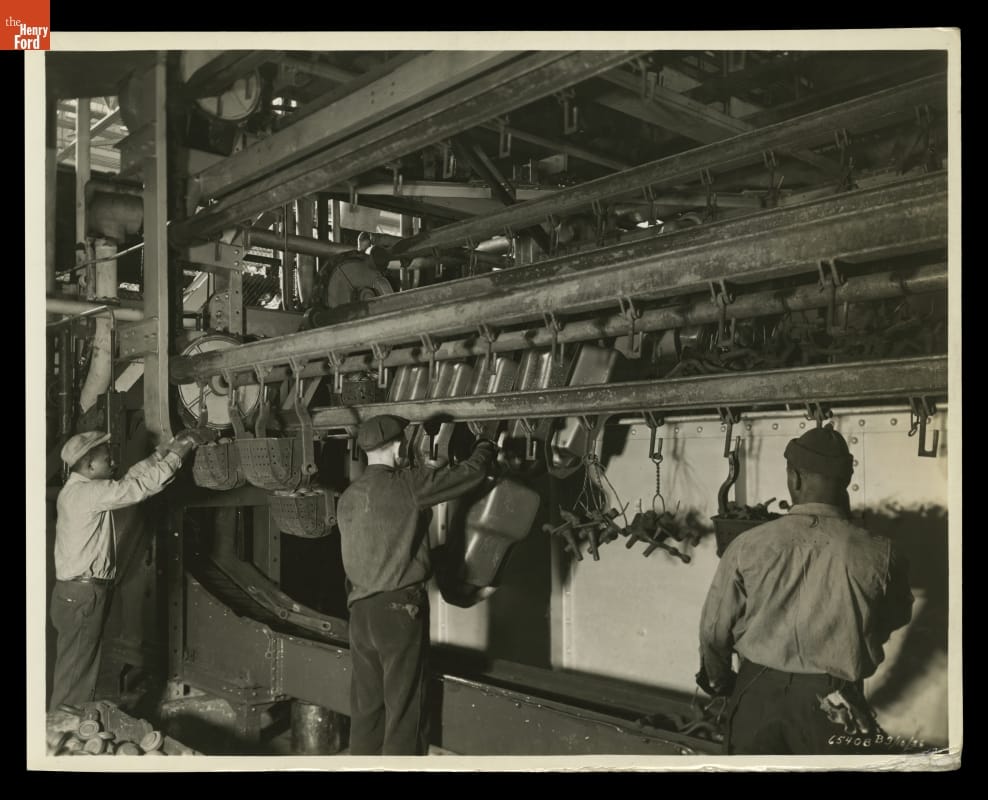
Photographic print - "Pickling Metal Crankcases and Other Parts to Remove Surface Impurities, Ford Rouge Plant, 1936" - Ford Motor Company Photographic Department
Discriminatory real estate practices played a significant role in the housing issues which plagued Detroit. Racially restrictive covenants, which legally ensured the sale of property to only white buyers, became increasingly common in Detroit. Even if a restrictive covenant was not in place, the Detroit Real Estate Board warned area realtors “not to sell to Negroes in a 100 percent white area,” thereby enforcing and perpetuating Detroit’s racial geography. Further, the practice of “redlining,” or the racial categorization of areas by their perceived financial risk in home insurance and mortgage lending, effectively shut out black homebuyers from the market. The practice extended to the lending of new mortgages, but also to home loans, leading to the inability to complete home repairs and, eventually, an abundance of blighted homes in black neighborhoods. In addition, real estate agents erroneously reported to white homeowners that the presence of black families in their neighborhoods would lower their property values. White homeowners, even those without ingrained prejudices against African Americans, certainly did not want their property values to lower, so rallied against any attempt by an African American homebuyer purchasing in their neighborhoods. The infamous story of African American Physician Dr. Ossian Sweet exemplifies the discrimination and mob violence experienced by those who attempted to move into white neighborhoods.
Discrimination in the workplace meant that African Americans, as a whole, made significantly less money than their white counterparts. Redlining practices forced them into racially-segregated neighborhoods and cemented their inability to access loans for mortgages or home repairs. Yet, the promise of the north continued to draw African Americans to Detroit. Without access to capital, increasingly-crowded neighborhoods became increasingly-deteriorated. At each turn, discriminatory systems excluded an entire population from quality housing. From these conditions, Charles H. Lawrence and his family departed Detroit in search of quality housing and a better life. He became the first African American to settle in Inkster, Michigan, and hundreds soon followed.
African Americans Settle in Inkster
The City of Inkster, also located in Wayne County, is approximately fourteen miles from downtown Detroit. Detroit Urban League President John Dancy fielded many housing inquiries from frustrated African American migrants to Detroit in the post-World War I period and beyond. Unable to locate sufficient housing in the City of Detroit, Dancy broadened his search outside the City with hopes that more rural areas would not have the same restrictive covenants and that lesser demand would persuade landowners to sell to African American buyers. In 1920, Dancy succeeded when he found amenable property owners in possession of 140 acres in rural Inkster. Although Inkster’s first African American residents’ settlement in Inkster preceded Dancy’s discovery, the 140 acres of available land enabled and impelled hundreds more African American families to move from Detroit to Inkster, despite the lack of a local government or basic public amenities like streetlights or sewer lines.
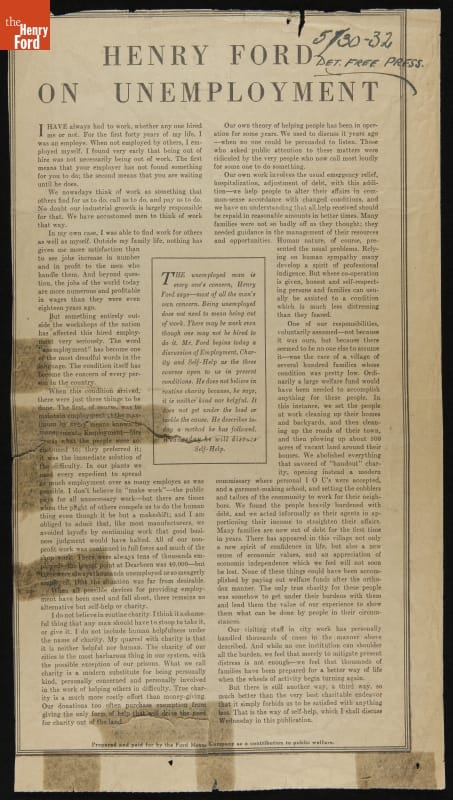
Clipping (Information artifact) - ""Henry Ford on Unemployment," 1932" - Detroit Free Press (Firm)
A Community Becomes a Project
Henry Ford was vocal about his disdain for institutionalized philanthropy. He wrote an entire chapter, entitled “Why Charity?” in an autobiography, and explained, “philanthropy, no matter how noble its motive, does not make for self-reliance…A philanthropy that spends its time and money in helping the world to do more for itself is far better than the sort which merely gives and thus encourages idleness.” Henry Ford’s brand of philanthropy was characterized by helping people help themselves. During the Great Depression, Henry Ford was called upon by the City of Detroit to provide aid because the City’s welfare offices were overwhelmed. Their argument, aside from civic responsibility, was that the City was not receiving taxes from Ford Motor Company (FMC’s factories were located outside Detroit) yet as many as “36 percent of the families receiving care from the City of Detroit were former Ford employees” in 1931. The public goodwill that Ford’s $5 a day policy brought was quickly dissipating. In 1931, Ford agreed to two philanthropic ventures; he provided a low-interest, short-term $5 million loan to the City of Detroit and essentially took the then-Village of Inkster under the Ford Motor Company’s auspices.
Photographic print - "Ford Motor Company Employee Home Improvement Project, Inkster, Michigan, 1930-1944" - Ford Motor Company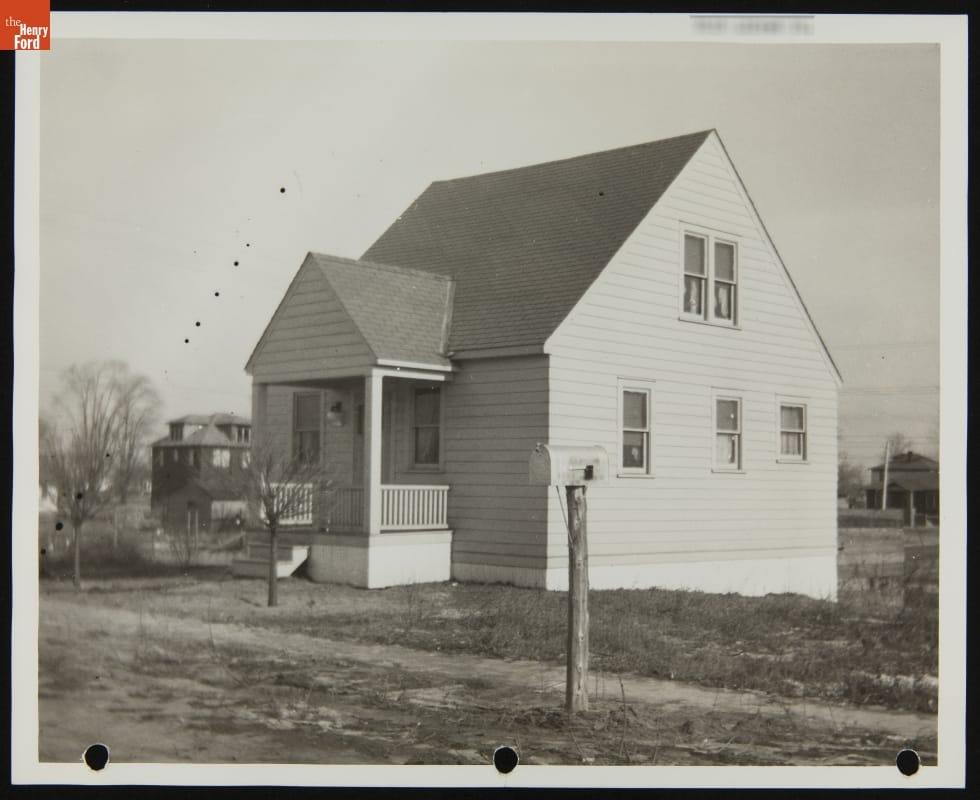
Photographic print - "Ford Motor Company Employee Home Improvement Project, Inkster, Michigan, 1930-1944" - Ford Motor Company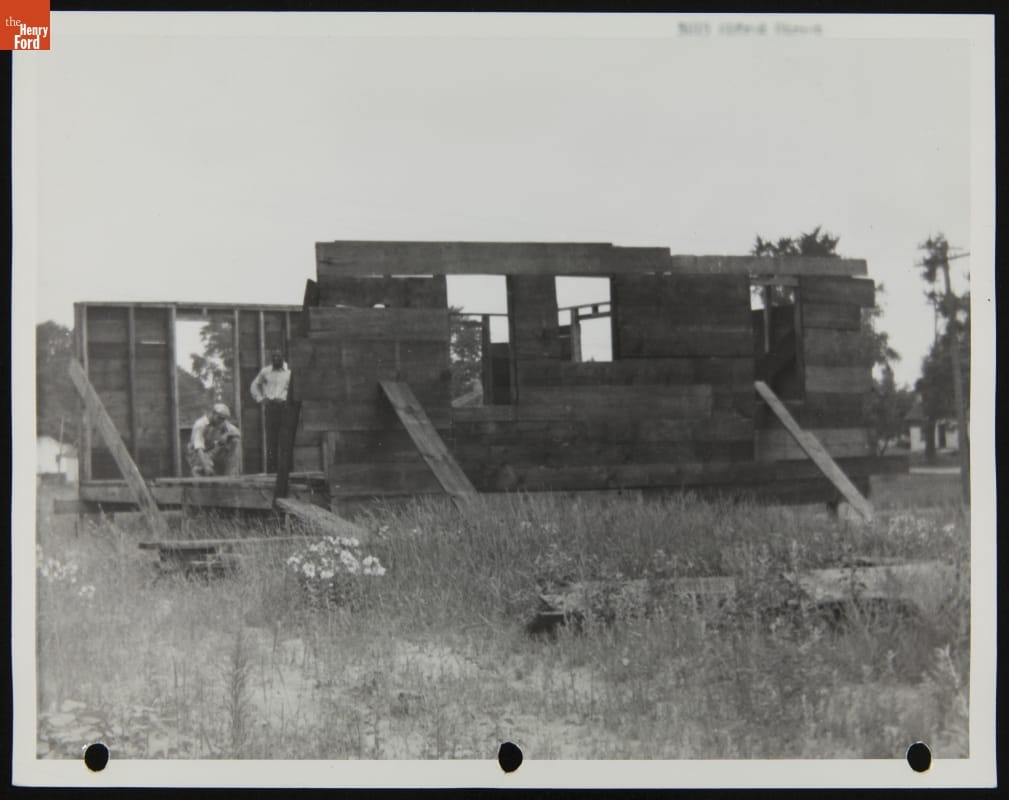
Photographic print - "Ford Motor Company Employee Home Improvement Project, Inkster, Michigan, 1930-1944" - Ford Motor Company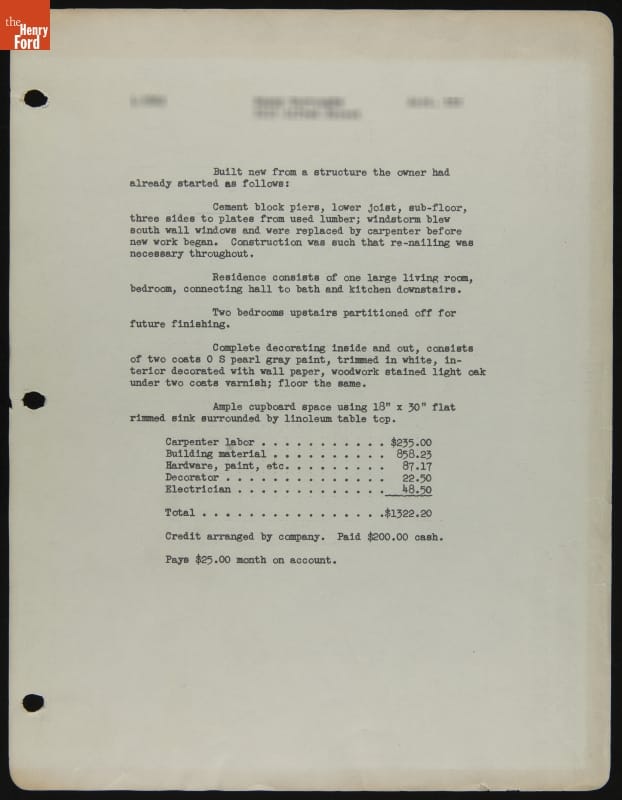
Report - "Ford Motor Company Employee Home Improvement Project, Inkster, Michigan, 1930-1944" - Ford Motor Company
By 1931, a few years into the Great Depression’s hardships, the residents of Inkster were struggling. Unemployment and debt were high, public services had been cut, and many residences remained partially-completed, as the Great Depression halted progress in the young village. Controversially, Henry Ford placed FMC’s Sociological Department in charge of what became known as the Inkster Project. The Sociological Department was created in 1914 in order to manage the diverse workforce and ensure employee adherence to the company’s strict standards, which were paternalistic in nature and often crossed the home life-work life boundary. In Inkster, the Sociological Department immediately began implementing programs to comprehensively rehabilitate the village. A commissary, which sold high-quality, low-cost food and essential home goods, was established. Coal was distributed to those who needed it to heat their homes. Debtors were paid off, and a medical clinic and school were constructed. Homes deemed insufficient were rehabilitated. The inability to pay for these services was irrelevant; a type of “I.O.U,” repayable through Ford-provided work and wages, was enough to access all life’s necessities.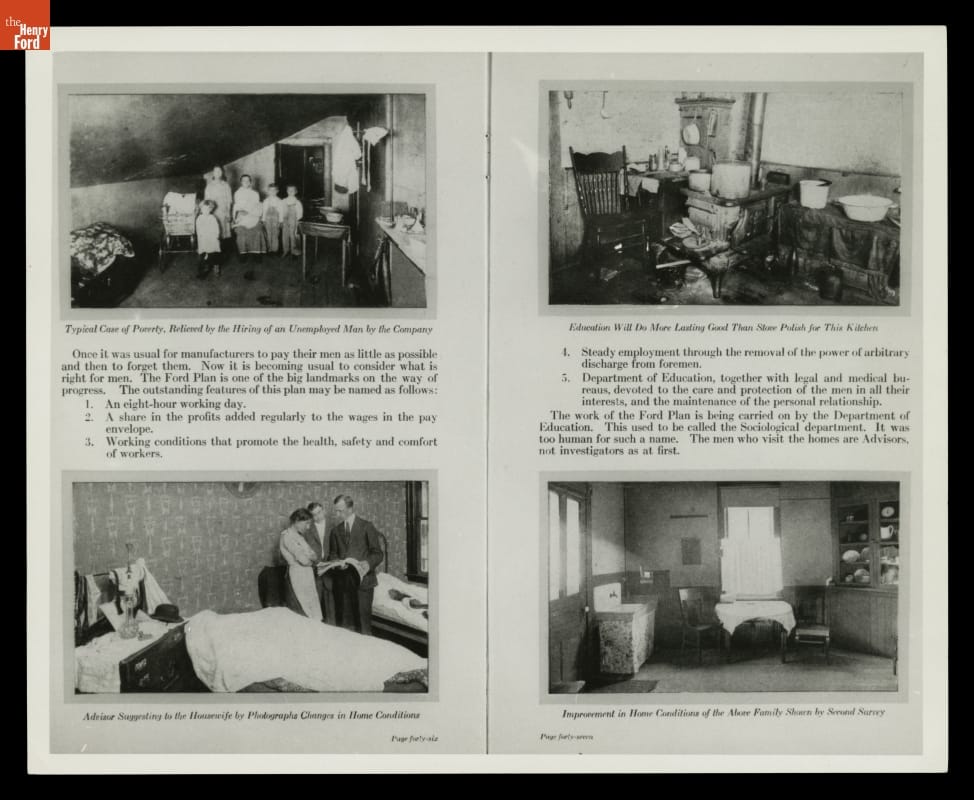
Photographic print - "Checking on Ford Employees Home Conditions, Views from "Factory Facts From Ford," 1917"
The Legacy of the Inkster Project
Although the Inkster Project was generally highly-regarded at the time, the FMC Sociological Department’s role was often overreaching. When agreeing to Ford’s aid, an Inkster resident was also agreeing to running their household as preferred by Henry Ford. Although his funds undoubtedly helped Inkster during the Great Depression, Ford’s motives were not entirely altruistic. Besides the much-needed public relations boost he received from the Inkster Project, he also was able to assert his influence and ideals on a community that largely had no choice but to accept his aid -- with all strings attached.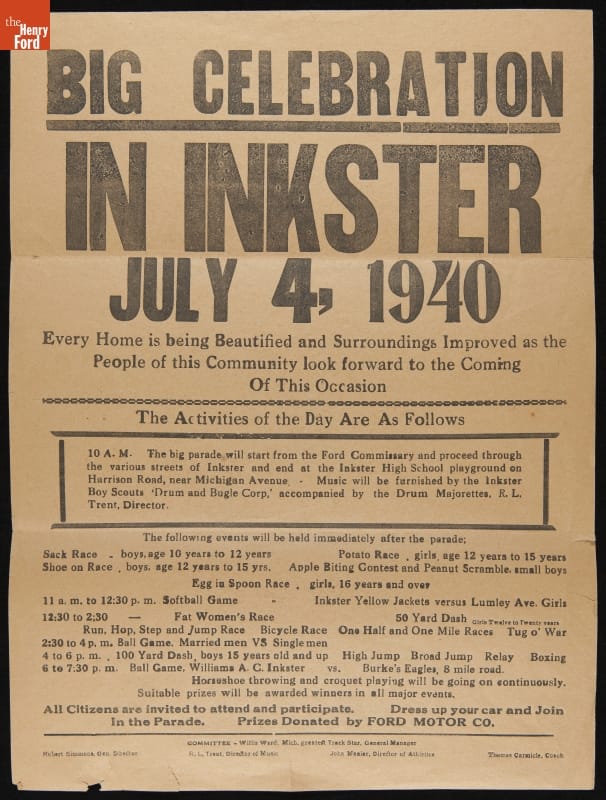
Broadside (Notice) - "Big Celebration in Inkster," July 4, 1940"
The Inkster Project’s legacy is complicated; many historians criticize Henry Ford’s paternalistic nature and the perhaps forceful imposition of his will onto the desperate, but others, including former residents of Inkster, praise Henry Ford for his aid. In her reminiscences, Georgia Ruth McKay explains that Inkster became a “jungle village changed into a city” during this period and that, “without his [Henry Ford’s] help, many would not have survived.” The Inkster Project was slowly phased out, but continued to operate in Inkster until 1941 when all programs were withdrawn.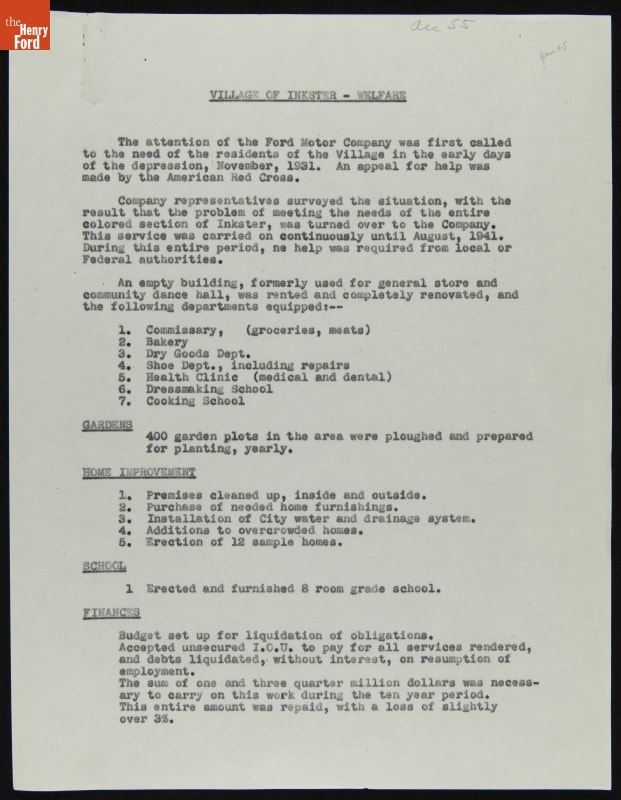
Progress report - "Village of Inkster Welfare Report, 1931-1941" - Ford Motor Company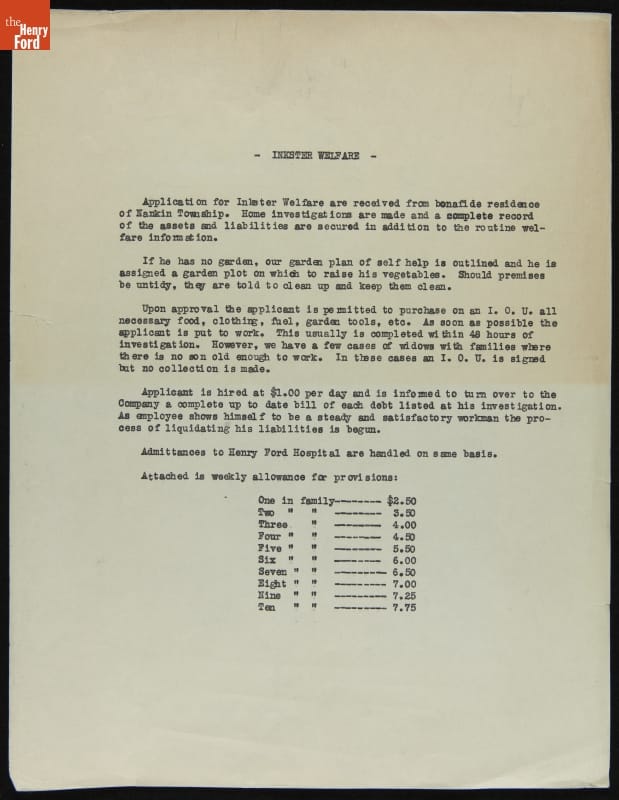
Report - "Village of Inkster Welfare Provision Report, circa 1936" - Ford Motor Company
Katherine White is Associate Curator, Digital Content, at The Henry Ford. In writing this piece, she appreciated the research and writings of Beth Tompkins Bates’ “The Making of Black Detroit in the Age of Henry Ford”, Thomas J. Sugrue’s “The Origins of the Urban Crisis; Race and Inequality in Postwar Detroit,”, and Howard O’Dell Lindsey’s dissertation, “Fields to Fords, Feds to Franchise: African American Empowerment in Inkster, Michigan.”
20th century, Michigan, labor relations, home life, Henry Ford, Ford workers, Ford Motor Company, Detroit, by Katherine White, African American history
Early Safety Innovations

What do Buster Keaton and Harold Lloyd have to do with Ford Motor Company? Well, besides the fact that Ford cars appear in a number of their films), the Ford Motor Company Safety Department. It’s strange to think of these two physical comedians as poster boys of safety, but through weekly films on safety issues the Safety Department used innovative techniques to prevent accidents by showing the right and wrong way of performing jobs and using machines and tools, often using Keaton and Lloyd films as comic examples of unsafe behavior. Safety, however, was taken very seriously at Ford and was seen as so important that early on in the 1910s the role of safety engineering and inspection was removed from the Medical Department and set up as a separate department.
Headed up by Robert Shaw, the department was established in 1914 and was responsible for machine safety, job safety, as well as hygienic safety (the full title of the department was the Safety and Hygiene Department). The first safety committee included P.E. Martin, C.E. Sorensen, C.W. Avery, the minutes stated: “it is the aim of the Safety Committee to reduce the number and serious nature of accidents. The assistance of every Ford man is needed in this work.” And assistance they got. By 1922, the department had around thirty inspectors, some general and some specialists, it also included a bacteriologist who examined areas in the factory to help stop the spread of disease, and a range of cleaners who sanitized, scrubbed, and scoured every inch of the factory to make sure the environment was as germ-free and clean for the workers as a factory could be.
Of the inspectors, some were general, and some specialized in specific areas or machines in the factory. John Wagner, who joined the department in 1922, worked on punch presses and noted when he started workers were losing an average of 16 fingers a month on press punches alone. Wagner designed several guards and safety mechanisms for machines, noting, “we never designed a guard like a pair of handcuffs that would pull men's hands back. I never approved of them. The men resented that type of guard. The sweep guard was not resented.” Shaw also noted that “we never liked harnessing a man to a machine.” Every machine in the factory was inspected and new guards or devices installed as necessary, any new machines had to be approved by the department, and they were consulted when new machines were being designed.
Shaw worked not only to fix machines that caused accidents, but also to heighten awareness of unsafe behavior and correct problems before they caused injury. Weekly safety bulletins were published, posters were posted, articles appeared in the Ford Man, and safety slogans and tips were printed on the back of each man’s timecard. Safety statistics for each department would be compiled monthly and distributed to all the departments for contests with departments competing against each other for the best safety record. The department hosted safety sessions where they showed movies, performed skits, and gave talks designed for individual departments and the safety hazards they faced. Safety rallies, parades, and picnics were hosted at different plants and branches in Detroit with the Ford Motor Company Band entertaining the crowd.

The department created safety cards for each job, which men has to read, sign, and turn in to the foreman who then carried them and used them to coach employees when they didn’t follow safety rules. Each new man was trained in safety procedures for his job before he started and was held accountable for complying with regulations. If a man was caught in violation of a safety regulation, such as running in the factory (with or without scissors), cleaning a machine while it was running, or using mushroom head tools that could catch and pull a man into a machine, they were sent up to the safety office to read through the safety bulletins and look at photos of industrial accidents from the plant. In rare cases of severe violation, a man was suspended, and if even more rarely, they were laid off for repeat safety offenses.

The pamphlet Factory Facts from Ford noted in 1917: “Safety work concerns not only the loss of fingers and injuries of this nature, but undertakes to protect the health of the men as well.” To this end the hygiene side of the department pumped in washed air “at just the right temperature for comfort and efficient work,” provided filtered and cooled water in drinking fountains that were sanitized multiple times a day, placed dust collection systems in dusty work areas, and scrubbed the floors at least once a week, boasting that cleaners swept “even the spaces which the average housewife passes over.”
Shaw extended the Ford safety program outside the company as well and was a founding member of the Detroit Industrial Safety Council. The council was composed of various Detroit area manufacturers and focused on reducing accidents through increased awareness, better machines and guards, and improving factory policies and environment.
Kathy Makas is a Reference Archivist for the Benson Ford Research Center at The Henry Ford. The Benson Ford Research Center is open Monday-Friday 9:00-5:00. Set up an appointment in our reading room or AskUs a question here.
labor relations, by Kathy Makas, Ford workers, manufacturing, Ford Motor Company

In May 1937, an event took place that would become a touchpoint and rallying cry in the history of labor organization: the Battle of the Overpass. Numerous United Auto Workers organizers, including Walter Reuther and Richard T. Frankensteen, arrived at the Ford Motor Company Rouge plant in Dearborn, Michigan, shortly before shift change, intending to hand out flyers to plant workers. Instead, the organizers were attacked by Ford employees. We have just digitized a number of photographs documenting those events, including this one showing union representative Robert Sentman being chased by Ford Service Department men. View photos from our digital collections about the Battle of the Overpass, or learn more about the day’s events and aftermath on our website and via the Walter P. Reuther Library.
Ellice Engdahl is Digital Collections and Content Manager at The Henry Ford.
Ford Rouge Factory Complex, Michigan, Dearborn, digital collections, by Ellice Engdahl, labor relations, Ford workers, Ford Motor Company
Ford’s Five-Dollar Day

On January 5, 1914, Henry Ford and his vice president James Couzens stunned the world when they revealed that Ford Motor Company would double its workers’ wages to five dollars a day. This groundbreaking decision for the average Ford assembly line worker salary generated glowing newspaper headlines and editorials around the world. The notion of a wealthy industrialist sharing profits with workers on such a scale was unprecedented.
In the century since, many theories have been posited for Ford’s bold move. Some suggested the increase was to justify assembly line speed-ups. Others speculated it was to counteract high labor turnover due to increasingly monotonous assembly line work. Ford admirers believed it was pure philanthropy and a progressive step towards improving Henry Ford's workers' rights. Cynics asserted that it was little more than an elaborate publicity stunt. As usual, the truth lay somewhere in the middle.
More Monotony, But More Money
To a large degree, Ford’s implementation of the Five-Dollar Day cannot be appreciated without first understanding his advances with the moving assembly line. Experiments through 1913 and into 1914 reduced the time required to build a Model T automobile from 12½ hours to a mere 93 minutes. Increased efficiencies lowered production costs, which lowered customer prices, which increased demand. The public was eager to buy all of the cars Ford could build.
Explosive production gains came at the cost of worker satisfaction. The very goal of the moving assembly line was to take what had been relatively skilled craftwork and reduce it to simple, rote tasks. Workers who had taken pride in their labor were quickly bored by the more mundane assembly process. Some took to lateness and absenteeism. Many simply quit, and Ford found itself with a crippling labor turnover rate of 370 percent. The assembly line depended on a steady crew of employees to staff it, and training replacements was expensive. Ford reasoned that a bigger paycheck might make the factory’s tedium more tolerable.

If the need to retain workers was a partial motivation for the Five-Dollar Day, then the solution may have worked too well. Within days of the announcement, thousands of applicants came to Detroit from all over the Midwest and entrenched themselves at the Ford’s gate. The company was overwhelmed, riots broke out, and the crowds were turned away with fire hoses in the icy January weather. Ford announced that it would only hire workers who had lived in Detroit for at least six months, and the situation slowly came under control.
Strings Attached
Those who secured jobs at Ford soon discovered that the generous Ford worker salary came with conditions. Lost in the headlines was the fact that the pay increase was not a raise per se, it was a profit sharing plan. If you made $2.30 a day under the old pay schedule, for example, you still made that wage under the Five-Dollar plan. But if you met all of the company’s requirements, Ford gave you a bonus of $2.70.
Part of Henry Ford’s reasoning behind the Five-Dollar Day was that workers who were troubled by money problems at home would be distracted on the job. If higher pay was intended to eliminate these problems, then Ford would make sure that his employees were using his largesse “properly.” The company established a Sociological Department to monitor its employees’ habits beyond the workplace.
To qualify for the pay increase, workers had to abstain from alcohol, not physically abuse their families, not take in boarders, keep their homes clean, and contribute regularly to a savings account. Moral righteousness and prudent saving were all well and good, but they were not generally an employer’s business—at least not outside of working hours. In contrast, Ford Motor Company inspectors came to workers’ homes, asked probing questions, and observed general living conditions. If “violations” were discovered, the inspectors offered advice and pointed the families to resources offered through the company. Not until these problems were corrected did the employee receive his full bonus.
Modifying manufacturing methods was one thing. Modifying the people who carried out those methods was quite another. Henry Ford and his supporters may well have seen the Sociological Department as a benevolent tool to benefit his employees, but the workers came to resent the intrusion into their personal lives. Ford himself eventually realized that the Sociological Department was unsustainable. By 1921, it was largely dissolved.
Wages Up, Sales Up
As for charges that Ford raised pay in pursuit of publicity, there’s no question that the Five-Dollar Day brought a spotlight on Ford Motor Company. But publicity is fleeting, and the Five-Dollar Day’s impact was far greater than newspaper headlines. Other automakers soon boosted their own wages to keep pace with Ford. Automobile parts suppliers followed suit. In time, workers in any number of fields were earning genuine “living wages” that afforded them comfort and security above basic food, shelter and clothing needs.
It’s no small detail that, as Henry Ford slyly observed, in the course of improving his employees’ standard of living, Ford also created a new pool of customers for his Model T. The Five-Dollar Day helped to bring members of America’s working class into its middle class. Better wages, combined with the affordable goods produced by the assembly line, are cornerstones of the prosperity that has characterized American life for so many of the past 100 years.
Matt Anderson is Curator of Transportation of The Henry Ford.
20th century, 1910s, Michigan, manufacturing, labor relations, Henry Ford, Ford workers, Ford Motor Company, Detroit, by Matt Anderson
African American Workers at Ford Motor Company

No single reason can sufficiently explain why in a brief period between 1910 and 1920, nearly half a million Southern Blacks moved from farms, villages, towns and cities to the North, starting what would ultimately be a 50-year migration of millions. What would be known as the Great Migration was the result of a combination of fundamental social, political and economic structural problems in the South and an exploding Northern economy. Southern Blacks streamed in the thousands and hundreds of thousands throughout the industrial cities of the North to fill the work rolls of factories desperate for cheap labor. Better wages, however, were not the only pull that lured migrants north. Crushing social and political oppression and economic peonage in the South provided major impetus to Blacks throughout the South seeking a better life. Detroit, with its automotive and war industries, was one of the main destinations for thousands of Southern Black migrants.
In 1910 Detroit’s population was 465,766, with a small but steadily growing Black population of 5,741. By 1920 post-war economic growth and a large migration of Southerners to the industrialized North more than doubled the city’s population to 993,678, an overall increase of 113 percent from 1910. Most startling, at least for white Detroiters, was the growth of the city’s Black population to 40,838, with most of that growth occurring between 1915 and 1920.

Photo: P.833.34535 Fordson Tractor Assembly Line at the Ford Rouge Plant, 1923
Before the war, Detroit’s small Black community was barely represented in the city’s industrial workforce. World War I production created the demand for larger numbers of workers and served as an entry point for Black workers into the industrial economy. Growing numbers of Southern migrants made their way to Detroit and specifically to Ford Motor Company to meet increased production for military and consumer demands.
By the end of World War I over 8,000 black workers were employed in the city’s auto industry, with 1,675 working at Ford. Many of Ford’s Black employees worked as janitors and cleaners or in the dirty and dangerous blast furnaces and foundries at the growing River Rouge Plant’s massive blast furnaces and foundries. But some were employed as skilled machinists or factory foremen, or in white-collar positions. Ford paid equal wages for equal work, with Blacks and whites earning the same pay in the same posts. Throughout the 1920s and 1930s Ford Motor Company was the largest employer of Black workers in the city, due in part to Henry Ford’s personal relationships with leading Black ministers. Church leaders in the Black community helped secure employment for hundreds and possibly thousands, but more importantly, they also helped to mediate conflicts between white and Black workers.
Photo: P.833.55880 African American workers at Ford Motor Company’s Rouge River Plant Cyanide Foundry, 1931
Photo: P.833.57788 Foundry Workers at Ford Rouge Plant, 1933
Photo: P.833.59567 Pouring Hot Metal into Molds at Ford Rouge Plant Foundry, Dearborn, Michigan, 1934
In addition to jobs, Ford Motor Company provided social welfare services to predominantly Black suburban communities in Inkster and Garden City during the depths of the Great Depression. Ford provided housing and fuel allowances as well as low-interest, short-term loans to its employees living in those communities. Additionally, Ford built community centers, refurbished several schools and ran company commissaries that provided inexpensive retail goods and groceries. (You can learn more about the complicated history of Ford and Inkster in The Search for Home.)
You can learn more by visiting the Benson Ford Research Center and our online catalog.
Peter Kalinski is Racing Collections Archivist at The Henry Ford. This post was last updated in 2020 with additional text by Curator of Transportation Matt Anderson.
20th century, Michigan, labor relations, Ford workers, Ford Motor Company, Detroit, by Peter Kalinski, African American history




